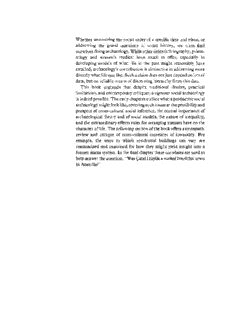
The Archaeology of Rank (New Studies in Archaeology) PDF
Preview The Archaeology of Rank (New Studies in Archaeology)
Whether uncovering the social order of a specific time and place, or addressing the grand questions of social history, we often find ourselves doing archaeology. While other fields (ethnography, prima- tology and women's studies) have much to offer, especially in developing models of what life in the past might reasonably have entailed, archaeology's contribution is distinctive in addressing more directly what life was like. Such a claim does not just depend on lots of data, but on reliable means of discerning hierarchy from this data. This book contends that despite traditional doubts, practical limitations, and contemporary critiques, a rigorous social archaeology is indeed possible. The early chapters outline what a productive social archaeology might look like, covering such issues as the possibility and prospect of cross-cultural social inference, the central importance of archaeological theory and of social models, the nature of inequality, and the extraordinary effects rules for arranging statuses have on the character of life. The following section of the book offers a systematic review and critique of cross-cultural correlates of inequality. For example, the ways in which residential buildings can vary are summarized and examined for how they might yield insight into a former status system. In the final chapter these correlates are used to help answer the question, "Was £atal Hiiyiik a ranked Neolithic town in Anatolia?" NEW STUDIES IN ARCHAEOLOGY Series editors Colin Renfrew, University of Cambridge Jeremy SablofT, University of Pittsburgh Clive Gamble, University of Southampton Archaeology has made enormous advances recently, both in the volume of discoveries and in its character as an intellectual discipline: new techniques have helped to further the range and rigour of inquiry, and encouraged inter-disciplinary communication. The aim of this series is to make available to a wider audience the results of these developments. The coverage is worldwide and extends from the earliest hunting and gathering societies to historical archaeology. For a list of titles in the series please see the end of the book. NEW STUDIES IN ARCHAEOLOGY The archaeology of rank PAUL K. WASON Bates College The archaeology of rank CAMBRIDGE UNIVERSITY PRESS PUBLISHED BY THE PRESS SYNDICATE OF THE UNIVERSITY OF CAMBRIDGE The Pitt Building, Trumpington Street, Cambridge, United Kingdom CAMBRIDGE UNIVERSITY PRESS The Edinburgh Building, Cambridge CB2 2RU, UK 40 West 20th Street, New York NY 10011-4211, USA 477 Williamstown Road, Port Melbourne, VIC 3207, Australia Ruiz de Alarcon 13,28014 Madrid, Spain Dock House, The Waterfront, Cape Town 8001, South Africa http://www.cambridge.org © Cambridge University Press 1994 This book is in copyright. Subject to statutory exception and to the provisions of relevant collective licensing agreements, no reproduction of any part may take place without the written permission of Cambridge University Press. First published 1994 First paperback edition 2004 A catalogue record for this book is available from the British Library Library of Congress cataloguing in publication data Wason, Paul K. The archaeology of rank / Paul K. Wason. p. cm. — (New studies in archaeology) Includes bibliographical references and index. ISBN 0 521 38072 3 hardback 1. Social archaeology. 2. Social classes — History. 3. Social structure - History. I. Title. II. Series. CC72.4.W37 1994 930.1-dc20 93-42094 CIP ISBN 0 521 38072 3 hardback ISBN 0 521 61200 4 paperback TO NINA CONTENTS List of figures and tables page xi Acknowledgments xiii 1 The present study of past society i The gap to be bridged 3 The logical possibility of social inference 3 The plan 12 2 Social theory and social life: models of society in the archaeological study of status 15 Social models in the archaeological study of inequality 18 Social models and social life 19 Material manifestations of socially significant actions 23 Ethnographically-based models and data in archaeology 26 Activities and the archaeological record 30 Implications for the design of archaeological correlates of social hierarchy 33 3 Inequality and social life: a working model 36 Inequality as an instituted process 36 Models and the significance of inequality for real life 40 Models of unranked society 41 Models of non-stratified ranking 44 Models of social stratification 57 Models and the archaeological recognition of inequality 66 4 Mortuary data as evidence of ranking, Part 1 67 Osteology, paleopathology, and demography 72 Energy expenditure and rank 76 Inferences based on general principles of the society 80 Alternative factors affecting overall emphasis 84 5 Mortuary data as evidence of ranking, Part 2 87 Variation in tomb form 87 The use of collective burial 89 IX Contents Variation in the quantity of grave associations 93 Inferences based on the type of goods included 93 Mortuary distinctions which cross-cut age or sex 98 Spatial relationships among burials 101 The form and distribution of artifacts 103 Status markers: elite goods and sumptuary items 103 Hoards, residences, and regions 108 Regional artifact distributions and status 112 Implications of an uneven distribution within a region 114 The use of iconography to infer status 117 The archaeological recognition of social stratification 119 The inference of wealth 125 Status, settlements, and structures 127 The distribution of communities across the landscape 127 The level of individual settlements 134 The analysis of residential architecture 136 Non-residential construction 145 £atal Hiiyuk: a ranked Neolithic town in Anatolia? 153 (Jatal Hiiyiik in social perspective 154 Mortuary practices 156 Artifacts and their distributions 163 Settlements and architecture 171 Social inequality at Neolithic £atal Hiiyiik? 178 Notes 180 References 188 Index 203
Description: